Waste plumbing, more important than electronics!
I don’t know if I’ve messed up my karma somehow, but I do know that the last year has included an unusual amount of hand’s-on time with blackwater systems. In fact, it was about this time last summer that I had to abort a cruise because I could not fix a jammed-up Lavac marine toilet. It did not help that the nice bag of spare parts that came with Gizmo were actually for an earlier model of the head’s electric pump. But now I have the correct spares and a good snake on board, along with a comfy plastic seat that can theoretically turn a standard five gallon bucket into an alternate head. And — my point in doing the work myself (aside from my Scotch blood) — I now understand the intricacies of the Lavac rather intimately, in case it again needs repair in a remote location…
And ditto for Gizmo’s Jabsco 18590 macerator pump, which also failed last season. Now we don’t absolutely need an overboard pump because we have a proper holding tank and there finally are numerous pumpout stations around (Camden has two — one on a boat run by the town and the other at Wayfarer). But then again, a full tank can be as much of a cruising bummer as plugging the head, plus the Weema tank level sensor involved is not exactly reliable. So over the winter I rebuilt the Jabsco. Twice. And it still didn’t pump the tank out!
Gizmo now has a brand new and fully functional Jabsco macerator pump (I didn’t have much choice due to seacock size) and, oh man, am I familiar with that system (even if I don’t yet know what ails pump #1). But all this pales in comparison to my home, where I have suffered from wastewater anxiety since August, 1979. That’s when the little stream went dry and we realized that the septic system for the fixed-up shack we’d bought — it was still bigger than the sloop — was just an old concrete tank and a short pipe. The clever, and completely approved, fix at the time was a submersible pump in the bottom of the old tank and 200 feet of 2-inch compression hose run under the stream and up the road to the end of the town sewer line. It worked, too, except for the time someone flushed a wash cloth, and later a comb. And at some ugly repair point in the early 80’s I built a heavy wooden frame and cover to improve accessibility, though it was still almost a foot under what would become a driveway when I replaced the original structure with a garage and an addition to the “new” house.
But then I didn’t think about that system for a long time, except for the occasional anxiety jag, especially, say, when the driveway was frozen solid and I was off in Florida while my family was home. In fact, when we pulled the whole mess of a DIY pump tank out of the ground a week ago today, the Goulds WSO511 pump had been running for over twenty years without ever seeing the light of day! (Think about that, Jabsco.) So naturally I got the same pump again but the real find was the company that custom fabricated the new 3,000 pound pump tank package and delivered it precisely when they said they would Friday morning, on a state-of-the-art boom truck able to reach deep into my lot under wireless control…
The company is American Concrete and if you’re up around here I can’t recommend them enough. Just check out my new control panel, pictured in action at top and opened up above. Note how well documented the pump and panel are, and what you can’t see well is the color-coded wiring diagram that made hooking up the direct-bury cable really easy. Also not pictured are the crack team who are fixing various issues with the house that somehow got old since I built it, or the excavator who is over 80 but seems capable of picking flowers with his machines. By Friday afternoon, the steel 6-inch riser and 24-inch manhole (sourced from India oddly enough) were in place, the tank was back filled, and the pump, float switch, and high “water” alarm were all tested. 2 Bisbee St. was back in business.
So what the heck does this have to do with marine electronics? Well, this is one of the primary tasks I felt mandatory before taking off for months at a time doing my most advanced electronics testing ever, while also getting Gizmo down the East Coast. It’s also a reminder to myself and maybe others about that important thing called “preventative maintenance.” I lucked out with that pump, big time, but I must remember to treat the plumbing, engine, and other critical systems on the boat with less laissez-faire. “Forehandedness” — the ability and drive to fix things before they break — is one of the prime attributes of good seamanship, I think.
Plus something I like to do with this blog is to point out well-managed companies with good technology, and American Concrete is all of that. An extra surprise on Friday was the fact that they stenciled my name on the tank parts as they moved through the production process. I’d long yearned for my own manhole, but what I got was even better.


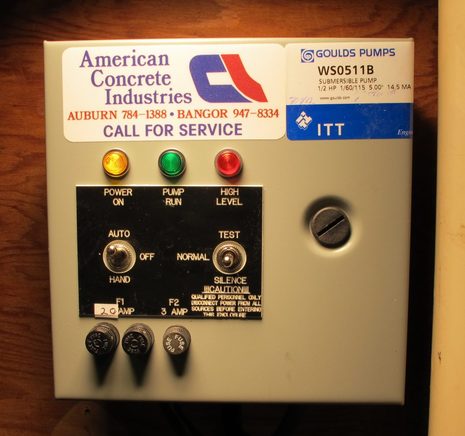
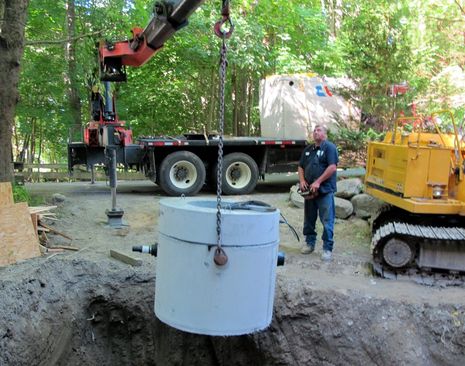

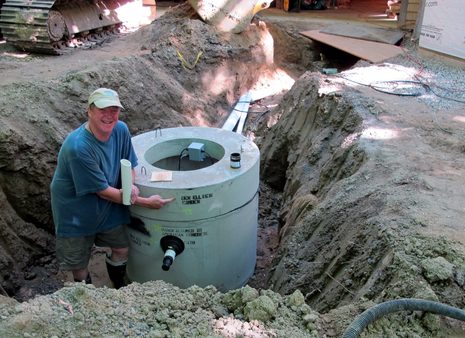

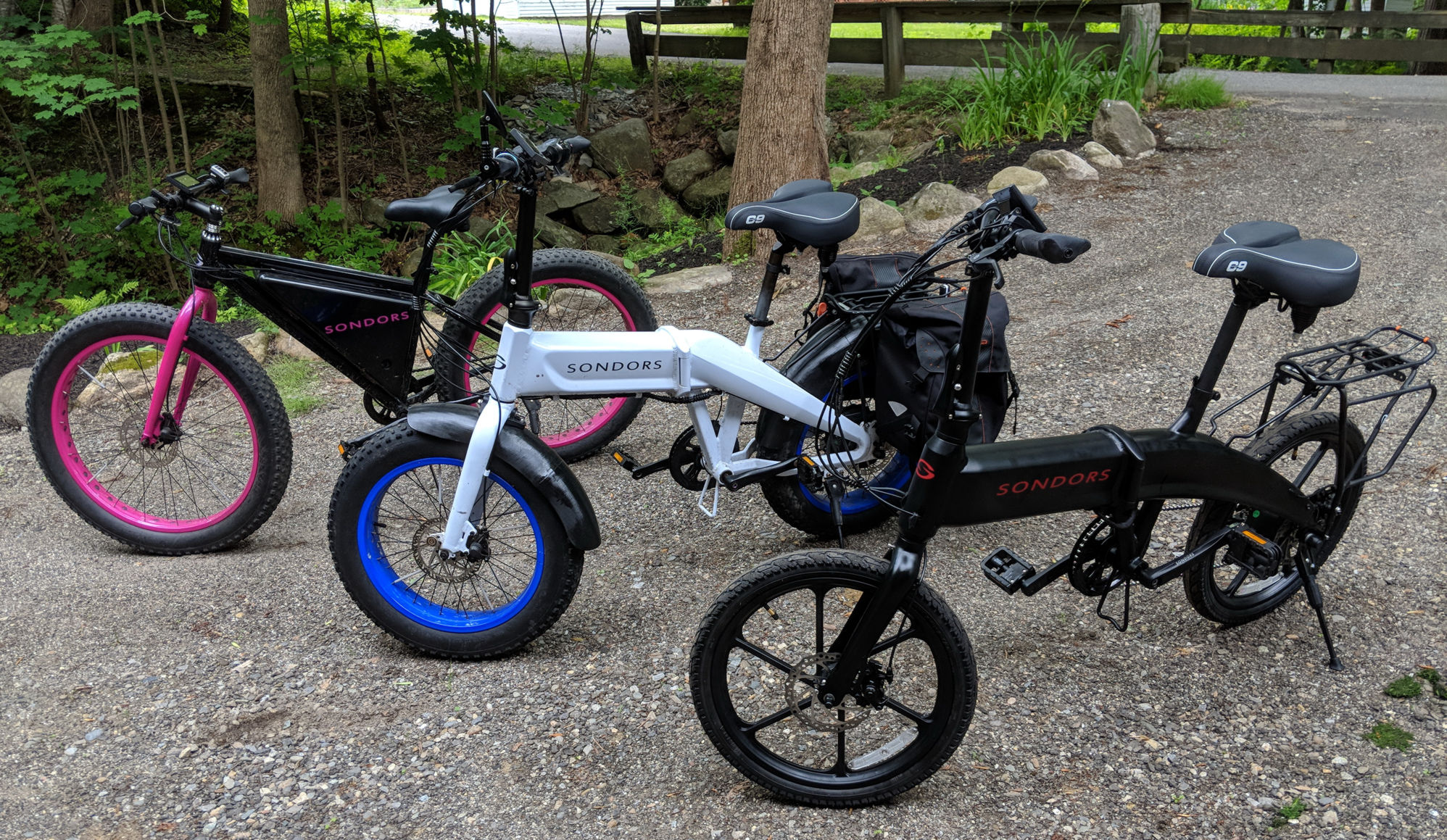

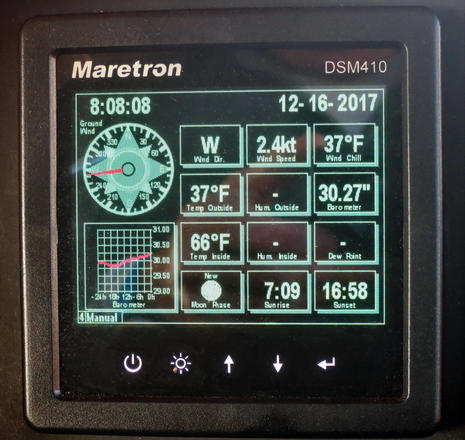







There was a local plumber in my town who had this little gem of wisdom painted on the back of his van:
“A straight flush always beats a full house.”
Glad to hear everything is in good order in Maine!
One year we ended up in the Canadian Gulf Islands with an inop Jabsco macerator pump and no pump out stations nearby. I bought a replacement pump at a local marine store, only to find out that our boat’s factory installation did not allow access to the pump. In the end I re-plumbed the holding tank and located the new pump in an accessible area.
These pumps often fail or freeze up due to lack of use. Here are a few things that I found out you can do to increase the life of the pump:
1- Use it whenever possible (in a legal waste dumping area).
2- If you can’t use it, remove the rubber end plug and rotate the shaft with a screwdriver on a regular basis.
3- Check the voltage drop at the pump. They draw a lot of juice and often the wiring and switches on a boat are undersized. I ended up installing a relay close to the pump and running 10ga wire to it.
Raul
Wow, a pump tank named after you!!!. In 5000 years, an archaeologist from some distant planet will dig this thing up and wonder what it is, why a persons name is on it, and conclude that it probably has something to do do with the practice of jet pilots to put their names on their helmets.
A malfunctioning Jabsco macerator pump is not something I think about every day. Like they say, “I can’t understand why it doesn’t work. It ran fine the last time I used it two years ago.”
But how can one test it without incuring the wrath of the Coast Guard or going 3 miles off shore (In the US, further in other countries)? It’s easy to check if the motor is running, but is it pumping?
There is only one solution to macerator pump woes — install a Sealand T-series waste pump. They run dry; they run forever. They are worth every penny.
I also recently had head plumbing problems on New Morning. The problem turned out to be an extraordinary buildup of mineral deposits in the hose which eventually blocked the hose entirely and led to the failure of my Jabsco 59090 holding tank pump. I replaced one section of hose and found it was down to about a 1/2″ diameter.
So it’s possible that the pump problems are related to hose problems, not unlike heart problems being linked to blocked arteries. Gizmoo may have “high effluent plumbing pressure”!
Peggie Hall, the expert on such matters, advised that a corrective dose of 20% muratic (aka hydrochorlic) acid, left to stand for one hour would clear the hose, and a weekly maintenance dose of 1 cup of distilled white vinegar, also let stand for one hour would prevent this from happening again. As I found the sanitation hose very difficult to work with, I applied two rounds of muratic acid and now apply the white vinegar regularly.
Thanks, Steve. I’d like to have a diaphragm pump instead of an impeller but the Sealand T is actually a waste discharge pump not a waste macerator pump. That’s why its inlet and outlet are both 1.5-inch ID. The Jabsco also has a 1.5-inch inlet, but its outlet is 1-inch and it has a chopper blade. At any rate, to make the change I’d have to replace the 1-inch seacock with a 1.5-inch one, and I’m not willing to go that far (yet).
And thank you, Russ, for the medicinal specifics. Gizmo also came with a gallon of white vingegar, which I’ve used along numerous other cleaning solutions. I don’t think I have significant mineral build up, but then again the short hose from tank to Jabsco is very hard to inspect. But I do have a translucent Jabsco to seacock hose now, so I can actually see it work. (It sounded fine after both rebuilds.)
Thanks all for discussing this subject. Many folks don’t want to 😉
Ben our solution on board The SallyW this summer was to install a Vacuflush, it uses a tiny amount of fresh water to flush which eliminates the calcium buildup and allows us to pumpout less frequently. Also using fresh water seems te eliminate the odors considerably We have done the Mini Loop this summer and got to all the pump stations in time. Had to as we couldn’t discharge, no macerator pump and it would be illegal and irresponsible as well. In Canada pumpouts cost $20 so one goes as long as possible. See http://www.tugsallyw.blogspot.com
Funny, I also “over the winter I rebuilt the Jabsco. Twice. And it still didn’t pump the tank out!”
There are some number of parts, but the pump design itself, with everything keyed so that it only fits together one way, appeared well designed to allow a sailor to easily succeed at a rebuild. But alas, both rebuilds failed in different ways.
When I read of peoples problems with complicated head systems it confirms our decision last year to install a Natures Head composting toilet on NiSa.
When our old Lectra San finally became useless last year we faced a big decision. Canada no longer approves the pleasure boat version of the Lectra San, which is a shame because it’s a great system. We did not have the space for a decent sized holding tank, nor did we really want all the complications and maintenance of such a system.
We did considerable research on composting toilets for boats and it was enlightening. The reports from users of the two popular composting toilet brands for boats, Natures Head and Airhead, unanimously were pleased with their choices. In a lot of years boating this is the first time I have read of a piece of boating equipment that everyone was happy with.
There are a few downsides, the biggest being the emptying of the urine jug. But they are far outweighed for us by the simplicity and reliability of the system. We are very pleased with our decison!
Where are our heads, folks? 6 comments in two days about a home septic tank, versus a ho-hum about some marine electronic minutiae in our recent past!It _is_ said that at some point in the aging process, our preoccupations turn from procreation to elimination.
Yep, that is an electric bellows pump. Should work great. I had a manual bellows pump (i.e. a manual diaphram bildge pump of large size) on my last sailboat for holding tank discharge and it never once needed attention. On current sailboat Jeanneau uses a gravity fed system – no pump! Works great. Also eliminates a Y valve and extra plumbing.
That translucent hose will smell quite interesting very soon! ugh. use head hose.
Ben, I had a VacuFlush and wasn’t happy with it. It was a factory certified installation. After 1 year I removed it. I ended up purchasing a Raritan Marine Elegance the standard model is a freshwater head that would macerate a tree limb if needed. I still use the SeaLand T series pump to feed my PuraSan Hold-N-Treat system when I am not in NDZ’s when I can legally discharge I turn on the Hold-N-Treat and it will treat then empty the tank and shut off when the holding tank empty. The Marine Elegance I chose has a 4 button smart control, normal flush, empty bowl, manual fill the bowl and a 3 cycle flush. The amount of freshwater that enters the bowl is programmable, it has a Porcelan bowl and a full sized seat. It draws 6 amps while flushing. It uses the same amount of water (or less) then the VacuFlush. They also make a rawwater/freshwater either or system if you don’t have enough freshwater onboard you can switch to the raw water feed. I almost always use the freshwater flush option.
Bill
MV;Wireless One
Ben,
I’m truly surprised that the Lavac itself has given you problems. There are no moving parts. Having had two Lavacs for over thirty years w/o problems I note that the problems I had were with the external pump rather than the head itself. Hope this is the end of your head problems for the next 30 years.
Don
re: Jabsco rebuild – If the motor runs but doesn’t pump, check that the motor is turning in the right direction. If either the field magnets or the brush plate were rotated 180 degrees, it would run backwards. The easy fix is to reverse the polarity on the power leads.
It seems like this shouldn’t happen. The various parts should be keyed so they always go together in the proper orientation.
re: Jabsco Rebuild Kit, is focused on replacing the impeller, although other nearby parts get replaced. Rebuild does not involve disassembling the motor (at least not down to the magnets), just the pump is dissembled into many small parts.
The problem with ‘heads’ related kit is that is of a constant human scale ( obviously), it doesn’t scale down with the boat. My 27 foot sailboat had 2 thru-hulls, toilet , 2 manual pumps, diverter valve and a holding tank bigger than my diesel tank : I realised that half the forepart of the boat was devoted to excretion ! I ripped it all out ( blocked off the thru-hull holes)and replaced it with a lovely stainless steel bucket with a wooden seat and lid, also a chain to throw and retrieve the bucket. I polish the inside.
Keep it simple.
Actually if you spend large amounts of time on your vessel, my wife and I are almost full time live aboards 8-9 months a year. I can testify you want a reliable head, freshwater is really nice in controlling odors. Having a controlled treatment system and properly sized holding tank are important if you want to be good stewards. Having no way of discharging untreated waste is a plus. Since there are numerous NDZ’s when coastal cruising properly sizing the holding tank with the heads ability to flush with little water is a balancing act. I got one of the 1st pre production Marine Elegance heads from Raritan and it truley is trouble free. If you are getting low on water you can always grab a bucket of water from over the side of the boat and simply use the flush only option on the ME if you don’t have the raw water optional pump and selector or the ability to make your own freshwater I do. I installed a Spectra 12VDC watermaker and it uses about 1.2AH’s per gallon for frsehwater production including the flush cycle. Something my 450 watts of solar can easily produce in addition to keeping the house battery banks charged. A boat if planned properly should be thought of as a series of systems that should compliment each other. Any weakness in the design or installation can have a cascading effect.
However I can’t see the bucket and seat trick unless you plan on holding the buckets until you are 3 miles offshore in most costal areas.
Bill
MV:WIRELESS ONE
Glad someone mentioned the emptying of the bucket! I really like your description of a boat as a collection of systems but include people in the collection. We have different standards of acceptability. Some of us will accept more basic situations and others like to be more comfortable.
Simple is good, but please keep your buckets out of my tight little harbor! But I’ve used buckets, porta potties, and worse. Consider a 30-foot Hurricane Island Outward Bound School open cat ketch with as many as 15 students and instructors living aboard for many days at time without even a bucket head. Plus a diet heavy with lentils!
The protocol was to hang onto the forward shrouds and cantilever your hind end over the rail, and if life was good the boat was broad reaching and you were at least partially hidden behind the main. It was a “character building experience” we were told.
The Coast Guard put an end to that practice a long time ago, but not before I moved on to more civilized boating.
Anyone heard of “toshers”? They were the 19th century gents who apparently made a fair living by “sieving raw sewage in the dank, dangerous and uncharted sewers beneath the streets of London.” Apparently they also lived unusually long lives — for that period — possibly because their immune systems were always active. Great story here:
http://blogs.smithsonianmag.com/history/2012/06/quite-likely-the-worst-job-ever/
Cool link about Mayhew and the Toshers Ben. The Tosher’s job was truly offal.
Well played, Bill, and to get ever further off topic, I discovered that piece and many other great reads thanks to the Instapaper app and bookmark system and sites like longreads.com. I don’t understand how all this great content can be stripped of ads and cached for easy perusal offline, but it’s wonderful for boaters and other wandering readers. I’m now trying the similar “Pocket” system and it seems even better…
http://getpocket.com/
Just a note on personal experience with the Jabsco Macerator pump and Jabsco pumps in general: they tend to lose their ability to self-prime rather quicky. Tiny air leaks in dried out rubber seals cause them to spin uselessly unless they are mounted low and constantly immersed. Sometimes disassembly and liberal applications of silicone grease to the seals will revive them, but for effective pump-out situations nothing works like mounting them near the bottom of the holding tank…or so I’ve found.
I just wish my little Croatian town had a treatment/ sediment plant and an outflow pipe 3 miles long, the 3nm law is on the books but they are slow to act.
Also no pump-out station within 25 miles. I will investigate the dessication systems though, we never have a lack of heat.
Hahaha love the bit “a straight flush beats a full house.” How has your guys’ experience been with the gorman rupp pump so far? Any performance flaws to be wary about?
Sorry, Louis, I have no experience with your Gorman Rupp pumps. I used a Goulds WSO511B pump for this job and it’s been working flawlessly so far. I have high expectations for a long life as the same model Goulds pump it replaced was still working fine after more than 20 years in a dark nasty place. Thanks for asking, though 😉